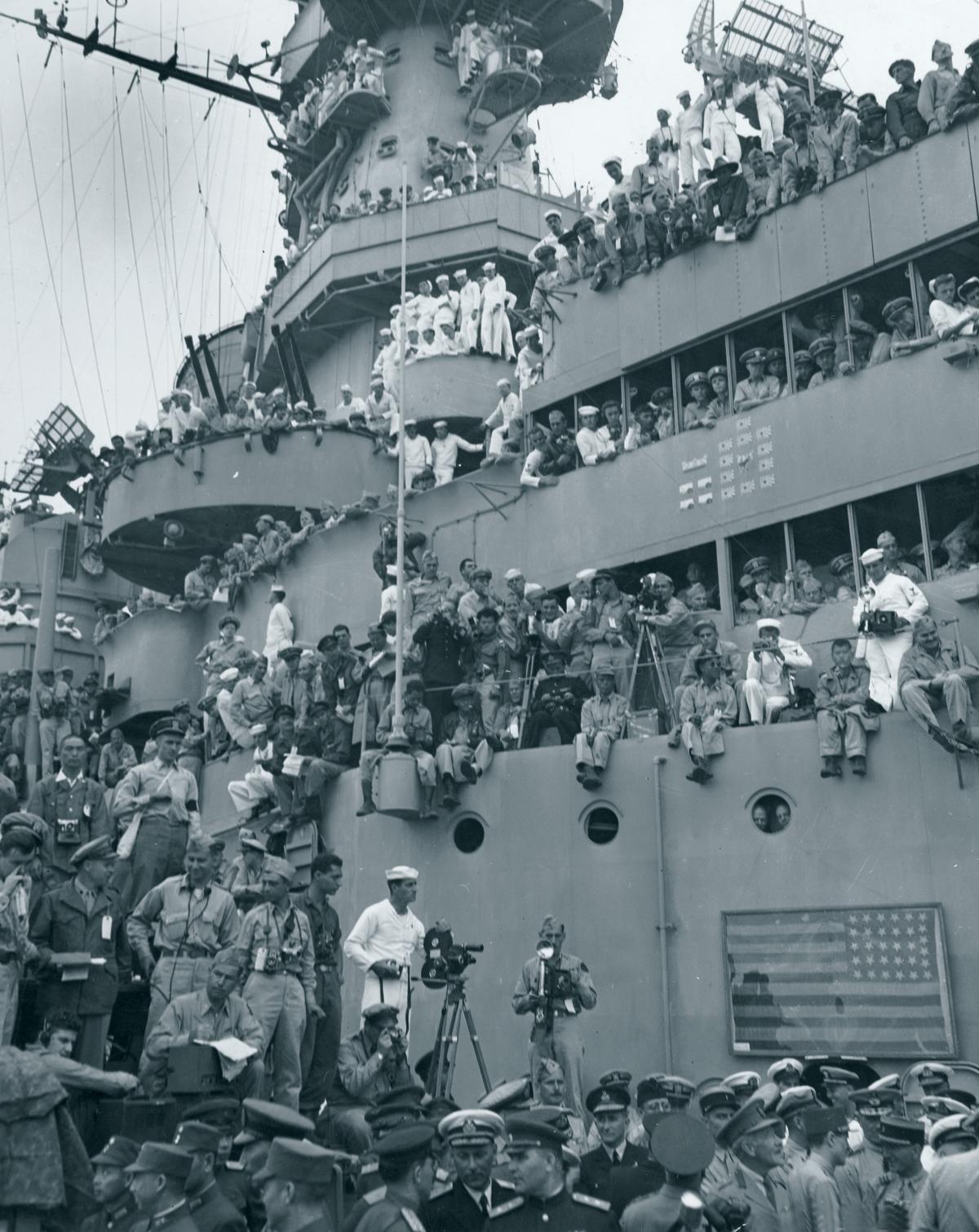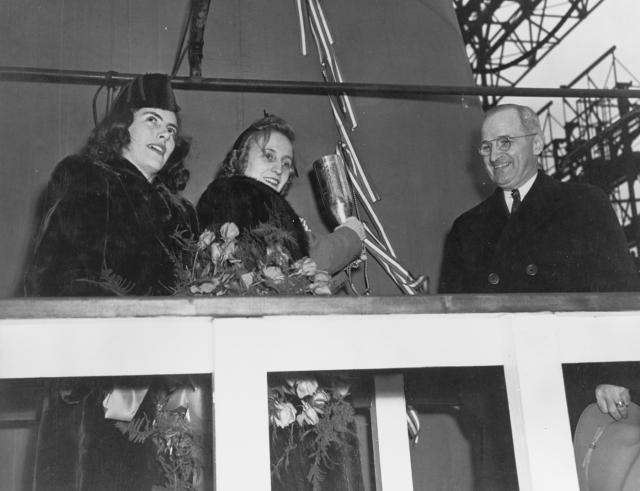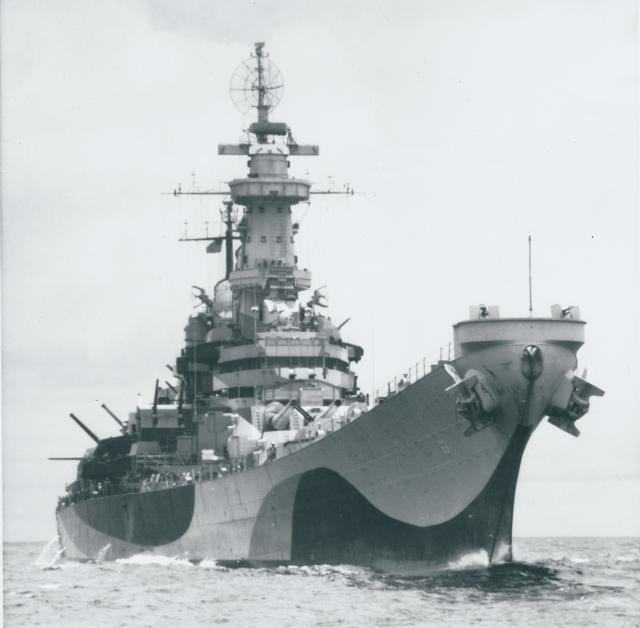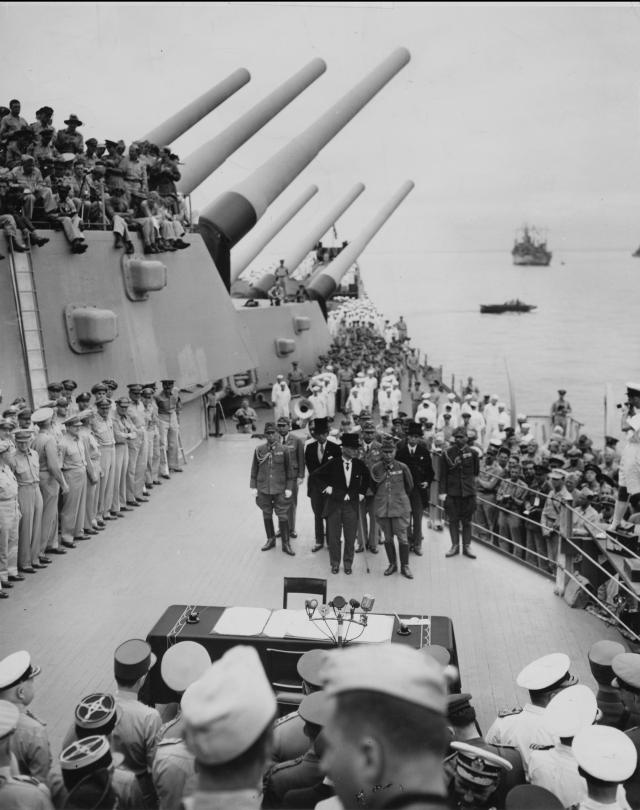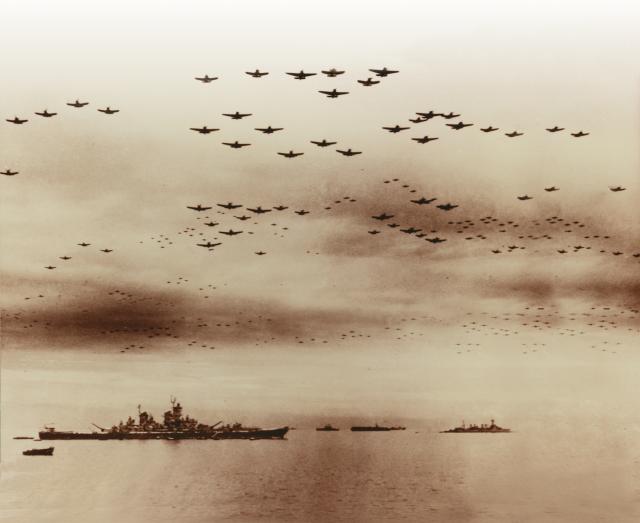Even for structures that eventually grew to immense proportions, their beginnings were quite small. So it was for the U.S. battleship that would serve as the site for the surrender that brought to a close the world’s biggest war.
On the brisk winter morning of 6 January 1941, a crane lifted two 60-foot pieces of steel onto a shipway at the New York Navy Yard in Brooklyn. Rear Admiral Clark Woodward, commandant of the Third Naval District, pushed down the handle of a machine that installed a rivet—a symbolic step in joining the first two keel plates. Nearby in the shipyard, the banging noises of construction sounded a welcome from the lead ship of the class, the Iowa (BB-61), to a younger sister. The new ship, designated BB-63, was to be called the Missouri. As with the Iowa, this recycled a name from a pre-dreadnought that had long since gone to battleship heaven.
Three years and three weeks later, by which time World War II had preoccupied the globe, the name became official. On another January day in Brooklyn, the 19-year-old sponsor, Margaret Truman, had the honor of christening the ship. She was the daughter of Missouri’s junior senator, Harry S. Truman. Margaret, who had been too excited to sleep the previous night, swung a bottle of champagne against a piece of metal that extended from the bow and said the magic words: “I christen thee USS Missouri.” She was splashed with sparkling wine from the bottle and jokingly complained years later, “I never got the smell of champagne out of that coat.”
Because of the timing of the tides for launching the massive hull, her father, Harry, had to compress his planned talk. Even so, it contained a prescient sentence: “The time is surely coming when the people of Missouri can thrill with pride as the Missouri and her sister ships, with batteries blazing, sail into Tokyo Bay.”
Brooklyn Beginnings
The Missouri was commissioned on 11 June 1944, a bright, sunny day in Brooklyn—quite a contrast to the weather for her keel-laying and christening. The principal speaker was Bennett Champ Clark, Missouri’s senior senator. In 1901, he had attended the launching of the earlier namesake, BB-11. Another individual associated with that previous Missouri was Captain William M. Callaghan, now the first skipper of the new behemoth. During the World War I era, he had made a midshipman cruise in the long-gone ship.
The new Missouri then went through trials in the Chesapeake Bay and the Atlantic. The first test-firing came on 31 July. The ship had sprouted a forest of small antiaircraft guns on her decks, 49 of the 20-mm variety and 80 40-mm. These chattered away noisily. Then the big moment came: At 1348, the right gun of turret one unleashed the first 16-inch projectile to the accompaniment of a cacophony of sound and an orange fireball. Before the afternoon was over, the 5-inch mounts fired as well, though by that time their sharp crack was somewhat anticlimactic.
Personnel training was the main purpose of the shakedown cruise. The disparate bodies from boot camps, training stations, and other ships of the fleet went through exercise after exercise to meld them into a unified fighting force. One of those bodies belonged to 18-year-old Fireman Bob Schwenk of California. For a particular drill, he was assigned as talker on a sound-powered telephone circuit. Water Tender Second Class John DeGrof was teaching him how to listen to calls on the phone line and relay the information. After a while, DeGrof asked, “What are they saying?”
Schwenk replied, “I don’t know. They’re speaking in a foreign language, and I can’t understand them.” The problem was that many of his shipmates spoke in the accents of New York, New England, and New Jersey; their manner of speech was unfamiliar to the Californian.
On 10 November, the Missouri began a long voyage to the war zone in the far Pacific. Also along were the Navy’s two oldest active battleships, the Arkansas (BB-33), commissioned in 1912, and the Texas (BB-35), from 1914. They had provided gunfire support for the Allied amphibious landings in France earlier in the year and now were headed to the other side of the world to take on new enemies.
Destination: Pacific
Once through the Panama Canal, the Missouri stopped at the San Francisco Navy Yard. Up until then, she had been painted in an Atlantic Ocean camouflage scheme, designed to thwart fire control setups by U-boats. It was a dazzle pattern with curving, irregular shapes of black, white, and gray. Now, when the threat was likely to come from the sky, she emerged with a paint scheme of dark gray and ocean blue.
The next stop en route to combat was Pearl Harbor, thence to the vast fleet anchorage at Ulithi Atoll in the Caroline Islands. She arrived there on 13 January 1945. The Missouri was the new kid on the block, surrounded by an array of warships with considerable combat experience. With no immediate operation on tap, the crew passed its time going ashore for recreation and sometimes watching open-air movies on the fantail. It took three tries to get through director Otto Preminger’s 1944 film noir Laura because rain intervened at times.
By that point in the war, which had involved the United States for more than three years, fast battleships had a secondary role. When they were designed in the late 1930s, their expected opponents were battleships of other nations. The Japanese attack on Pearl Harbor in December 1941 altered that calculus. Now aircraft carriers were the main offensive weapons in support of a series of island invasions that carried the war ever closer to Japan. The threat from Japanese heavy surface ships largely had been eliminated. The role for battleships in this new type of warfare was to use their clusters of antiaircraft guns to protect the carriers as they steamed together in task group formations.
A fast carrier task force, including its escorts, got under way for operations on 10 February, nearly a month after the start of the idle period at Ulithi. It brought an end to that age-old Navy syndrome, “Hurry up and wait.” The Missouri’s first deployment ushered her into another role for fast battleships—refueling oil-thirsty destroyers that also were part of carrier screens. One of the factors that made the carrier strike force so effective was its mobility. By 1945, the fleet had perfected underway replenishment as a means of keeping at sea for extended periods. Wags termed the battleships “armored oilers.” Lieutenant Doug Plate, a Missouri officer of the deck, once looked down and saw four destroyers being fueled at once—two to port and two to starboard. The image of suckling pigs comes to mind.
The Missouri’s fuel tanks held an impressive two and a half million gallons of heavy black sludge known as Navy special fuel oil. Unlike the distillate fuels burned in today’s warships equipped with gas turbines (seagoing jet engines), the black oil needed an additional step to do its job. Cylindrical burners, inserted into boilers, atomized the oil so it would burn, which the sludge would not. The heat produced steam within the boiler tubes, thus creating pressure that—through main engines and reduction gears—turned the propeller shafts. As the process continued day after day, with the ship often plowing through the water at more than 20 knots, she burned about 180 gallons of oil for each mile traveled.
A milestone in taking the war to the enemy came on 16 February, when the fast carriers, accompanied by the Missouri, launched the first U.S. strikes against Tokyo since April 1942. The occasion then had been a raid by B-25 Army Air Forces bombers from the carrier Hornet (CV-8) led by Lieutenant Colonel Jimmy Doolittle. It was a pinprick in terms of material damage, but it inflicted a wound to the Japanese psyche, which had considered the Home Islands invulnerable. Now, instead of pinpricks, Task Force (TF) 58 unleashed a deluge of ordnance. Many more bombs would hit Japan later.
Action Off Iwo and Okinawa
Shortly afterward, the task force headed for the island of Iwo Jima to support the amphibious assault there on 19 February. That evening, the Missouri recorded her first aircraft kill when a projectile from a 5-inch gun knocked down a twin-engine bomber at a range of 9,200 yards. All the investments in training exercises and ammunition paid their first dividend. Four days later came the symbolic flag-raising on Mount Suribachi, a treasured event in Marine Corps history. As TF 58 operations continued, the Missouri was for a time escorted by the destroyer Callaghan (DD-792). She was named for Rear Admiral Daniel Callaghan, who had been killed in 1942 in the naval Battle of Guadalcanal. His younger brother, William, was now skipper of the Missouri.
The end of the patrol came in a revisit to Ulithi. One evening, a kamikaze bored into the stern of the carrier Randolph (CV-15), which was anchored nearby. Gunner’s Mate Walt Yucka, on the fantail of the battleship, watched as flames climbed high after the initial explosion. Fear enveloped Seaman Joe Vella, a Missouri sailor new to combat, when he heard the strident call of the general quarters alarm. An experienced gunner’s mate said to him, “Take it easy; don’t get excited.” The words were reassuring at a tense moment in the teenager’s life.
During the next operation, the fast carriers and their escorts steamed in support of the upcoming invasion of Okinawa. That stepping-stone is only 340 miles from the closest point in the Home Islands. Japanese defenses were expected to be fierce. In preparation for the bombardment of the island’s southeast coast, men of the Missouri used contoured cardboard cutouts to create a terrain model to familiarize gunners with the target area. The bombardment on 24 March also involved sister ships New Jersey (BB-62) and Wisconsin (BB-64). It was really a feint, intended to deceive the Japanese as to the actual landing site.
One of the powder-hoist operators during the bombardment was Seaman Second Class Tony Alessandro, who controlled the supply of powder bags to the left gun of turret three. The hoist operator’s space was cramped; Alessandro qualified for the job in that he was 5-feet-6, 138 pounds, and did not suffer from claustrophobia. He used a lever to bring the powder from a belowdecks magazine handling room up to the gun room of the turret. Three at a time, the bags ascended and were put onto a brass tray that lay flat at the rear end of the 16-inch gun. Once the projectile had been rammed into the breech, another crewman took over with his lever and rammed in the three powder bags. Up came three more. On the aft end of the last bag was a red circle that covered a supply of black powder.
Once the breech was closed and sealed tightly, another shipmate inserted a primer the size of a shotgun shell into the firing lock of the breech. An electrical charge activated the primer, which shot into the black powder. That impulse initiated a chemical reaction that exploded the six powder bags. They sent the projectile spiraling out through the rifled gun barrel at a speed of some 2,000 feet per second—next stop, Okinawa. It was a rare use of the Missouri’s main battery guns during the war.
Kamikaze Trouble Times Two
The Japanese response to the Okinawa campaign was to unleash hordes of kamikaze planes toward the U.S. fleet. The principal targets were thin-skinned destroyers and aircraft carriers. The Missouri was the only fast battleship to be hit by suicide planes—not once, but twice. The ship’s senior chaplain, Commander Roland Faulk, was making his way to the bridge on the afternoon of 11 April. As he got to the top of a ladder, he was nearly run over by a stampede of crew members rushing from starboard to port.
A kamikaze plane was boring in from aft on the starboard side. Gun crew members described the Japanese pilot’s pose as akin to a jockey hunched over his horse. The left wing of the plane hit the hull just below the level of the main deck aft. The impact twirled the plane so that the propeller hub smashed into the ship’s side, leaving a dent still visible today. The kamikaze’s bomb did not explode, but the crash started a fire and sent the upper half of the pilot’s body onto the deck. Fire-fighting foam soon extinguished the blaze. The day after the incident, Chaplain Faulk conducted a burial service for the pilot. As part of the committal ceremony of the semi-corpse, Faulk said, “A dead Jap is no longer an enemy.” The former foe had been active and energetic the day before; now he plumbed the ocean’s depths. On 16 April, a second kamikaze clipped the ship’s airplane crane at the stern and fell harmlessly into the Missouri’s wake.
On the same date as the burial at sea, 12 April, a momentous event had occurred many time zones away. Franklin D. Roosevelt, who had been President of the United States for slightly more than a dozen years, died of a cerebral hemorrhage in Warm Springs, Georgia. His successor was Harry Truman, who had been elected Vice President in November 1944. Citizens of the United States were hit with a combination of shock and wonder, for Truman still was largely unknown to the populace at large.
One of the members of the Missouri’s crew was an unassuming quartermaster striker, John C. Truman. The son of the new President’s brother, he deliberately kept a low profile on board the ship. Two weeks later, he sent a handwritten letter to “Uncle Harry” in the White House. Among the sentences was one that probably expressed the thoughts of many U.S. citizens: “I still find it difficult to realize that you are the President.”
Enter the Bull
In mid-May, the Missouri’s flag quarters got a new occupant in the person of Commander, Third Fleet, Admiral William F. Halsey Jr. His first assignment after graduating from the U.S. Naval Academy in 1904 was the earlier battleship Missouri, nicknamed “Mizzy.” In his postwar memoir, Halsey compared the characteristics of the two Missouris—12,500 tons of standard displacement versus 45,000; the former’s four 12-inch guns were far surpassed by nine 16-inchers.
Halsey was an aggressive commander who had acquired the nickname “Bull.” It was he who commanded the air-sea onslaught that brought the Japanese nation to its knees. Among the crew of the flagship, Halsey soon acquired a reputation as a “sailors’ admiral.” One enlisted man, Radioman Richard “Moose” Connor, was intrigued and once asked Halsey’s Marine orderly if the admiral had ever chewed out a sailor. Back in Pearl Harbor, the Marine said, the admiral had come out of a building and collided with an enlisted man. Once they disentangled, the young sailor got up to walk away, whereupon Halsey retorted, “Wouldn’t it be customary to salute an admiral just after you knocked him on his ass?”
In the months ahead, the American ships—often under flak-filled skies, continued to steam as the carriers launched strike after strike against Japan. From 1 July to 27 August, the Missouri was under way continuously—thanks to frequent underway replenishments. By that time in the war, the service-force ships had developed the capability to deliver even large-caliber ammunition while at sea. Halsey, an old destroyerman, sought an opportunity for the fast battleships to do some shore bombardment.
The first came on 15 July, when the Iowa and Wisconsin joined the Missouri, cruisers, and destroyers in shelling steel works at Muroran, Hokkaido. Through the periscope of turret two, Ensign John Barron saw the exploding projectiles and the damage they wrought. Years later, Barron took his wife, Eleanor, to visit Muroran to show her the effects of the big guns. He was chagrined to discover that the steel plant had long since been repaired and production resumed. He endured some wifely teasing as a result.
In the first two weeks of August, as history has well recorded, U.S. B-29 Superfortresses unleashed atomic bombs on the cities of Hiroshima and Nagasaki. The Japanese gave up on 15 August and ordered a cessation of hostilities. An old Navy saying indicates that in any announcement, a small percentage of the intended recipients do not get the word. Halsey provided for that contingency in terms of uninformed Japanese pilots. He quipped, “Investigate and shoot down all snoopers—not vindictively, but in a friendly sort of way.”
Truman’s Prerogative
Then came the question of arranging for the formal surrender. Truman’s prophecy at the Missouri’s launching ceremony almost literally came true. The battleship did steam into Tokyo Bay on 29 August, albeit without guns blazing. Nevertheless, her gun batteries were manned and ready in the event of potential sabotage. In his post-presidential memoirs, Truman wrote it was he who directed that the Missouri be the site of the surrender. Other ships of the fleet had unquestionably made greater contributions to the victory, but this was personal. After all, his daughter had christened the ship in honor of their home state.
As the armada entered the bay, it included only one aircraft carrier. The concern about sabotage still existed, so the bulk of the carriers lay in wait outside, ready to retaliate if anything untoward happened. Lieutenant Bob Balfour of Halsey’s staff overheard the admiral tell of a letter he had written to his wife the night before. After mentioning Truman’s daughter, he wrote: “I only brought one aircraft carrier into Tokyo Bay with me. That’s the Cowpens [CVL-25], and that’s the one our daughter christened.” One of the provisions of the locale was that the large gathering of Allied ships had to anchor in sight of the Japanese main island, Honshu. This was unlike the German surrender in May, V-E Day, which was conducted in private.
Unsurprisingly, assignments to the surrender delegation were not eagerly sought. The principal signer on behalf of the Japanese government was to be Mamoru Shigemitsu, the foreign minister. He had lost part of a leg in an assassination attempt in 1933. The crew of the Missouri rehearsed incessantly for the big day, which was to be 2 September. To calculate the time the Japanese delegation leader would need to climb up from a destroyer to the surrender deck for the 0900 ceremony, a crewman walked the path, which included stairs, that Shigemitsu would take. He stuck a swab handle in his dungarees to simulate the stiff-legged gait of the Japanese emissary. His walk was timed and then twice that amount allocated.
‘The War Was Over’
On the day itself, Shigemitsu and other members of the delegation climbed a ladder to the 01 veranda deck just outside the captain’s cabin on the starboard side. The real ascent took even longer than the sailor’s swab-handle rehearsal. Once the 11-member Japanese delegation was in place, General of the Army Douglas MacArthur strode out from the admiral’s cabin and down a ladder to preside. An English-speaking Japanese delegate, Toshikazu Kase, had been prepared for the worst. He had expected the victor to be vindictive; instead MacArthur was conciliatory. After the speech, Shigemitsu and General Yoshijiro Umezo of the Japanese General Staff signed the surrender documents. Then MacArthur and representatives of the victorious Allied nations followed suit.
When the visitors had departed, rays of sunlight bored through holes in the clouds and danced on the surface of the water. In a way, they resembled the alternating red and white stripes of the Japanese Rising Sun flag. At a signal from Halsey, hundreds of U.S. planes flew low over the scene, at times so loud they drowned out speech. Gunner’s Mate Yucka was among the many crewmen who bore witness. Nearly 50 years later, chills struck him as he recalled the scene: “That was one of the greatest thrills of my life. The war was over.”
The date of 2 September 1945 was particularly special for Seaman Don Fosburg, a radioman striker in the Missouri’s crew. On that day, he celebrated the final birthday of his teenage years. Fosburg was back for the 70th anniversary celebration. On 2 September 2015, he turned 89 on board the surrender ship. During the ceremony, he was called forward—a complete surprise to him. He received an American flag that had flown over the ship. Usually such flags are presented to loved ones at military funerals. Fosburg, glowing with pride, received his when he could still smell the roses and remember being part of one of the momentous events of the 20th century.



